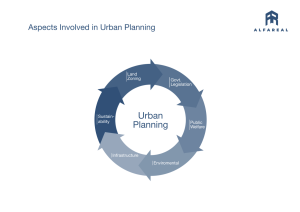Sun Tzu said it more than two millennia ago: “Think deliberately before making a move.” In the context of building a city, deep, future-focused urban planning is the key to sustainable development.
Planning is a fundamental tool for the development of prosperous and resilient communities. Investing in real estate projects that are aligned with planning at the city level are part of our commitment to a positive impact on society and the economy.
This article will look in detail at how urban planning can help create sustainable urban environments, using the case of the city of Amsterdam as a success story. With this we seek to motivate the real estate sector in Spain to consider the advantages it can have by focusing on projects that comprehensively address current urban challenges.
What is urban planning?
Urban planning is a complicated process that requires careful consideration of a variety of factors. It is a long process that requires a series of actions to ensure lasting success in the city where it takes place.
The first step is to collect information about the city or area. To better understand the needs and characteristics of the community, it is necessary to examine demographic, economic, social and environmental aspects. In addition, current and future trends are evaluated to find potential challenges and opportunities. An example of this can start from a single event (such as a natural disaster) or several, such as economic deprivations due to lack of infrastructure.
Afterwards, the analysis and evaluation is carried out. This requires the use of resources such as feasibility studies and environmental impact analysis. These tools enable informed decision making by helping to understand the implications of urban planning decisions in terms of economic, social and environmental aspects.
Then, the objectives and strategies of urban planning are established. These objectives may include promoting sustainability and the revitalization of degraded areas, as well as improving mobility and accessibility within a city. These objectives are achieved by developing strategies that take into account factors such as urban design, transportation management, housing, infrastructure, and green spaces.
Finally: The Urban Plan
After all this, an urban plan is finally created. It establishes the policies, regulations and measures necessary to carry out the vision of sustainable urban development. Land use, zoning, building density, heritage protection and promotion of public spaces are issues that are taken into account in the plan.
Finally, projects and policies are carried out to carry out the plan. This requires the collaboration of various actors, including real estate developers, local governments, communities and non-governmental organizations.
From this perspective, we understand that urban development depends not only on large investment initiatives with the desire to generate a positive impact, but also on the synergy of various entities working towards the same goal.
In other words, urban planning requires a comprehensive and participatory approach. It is essential that the real estate sector recognize its fundamental role in this process and commit to carrying out projects that promote the well-being of people and sustainable development in harmony with the urban environment. At Alfareal, we are part of that commitment.
What are the characteristics of an urban plan?

As we have discussed, carrying out an urban plan is a complicated task that requires experience and specialized knowledge in a variety of fields. To carry out this process effectively, it is essential to have specialists in planning and urbanism. These workers are trained to understand the challenges and opportunities that cities face and create strategies and solutions according to the needs of the communities.
In addition to planning specialists, governmental and non-governmental entities must work together. Urban plans are taken and carried out mainly by local governments, town planning departments and urban authorities. However, it is essential that the planning process involves civil society, community organizations and interest groups. Citizen participation allows the voices and needs of people who live and work in cities to be heard, leading to fairer and more sustainable decisions.
Some key principles of sustainable urban planning include smart densification. This seeks to optimize land use and promote efficiency in construction, and the promotion of sustainable mobility, which seeks to reduce dependence on cars and promote alternatives such as public transport, bicycles and pedestrians.
Importantly, urban planning also has a significant impact on our health. By promoting accessibility to green spaces, the creation of areas for physical activity and the reduction of pollution, more active and healthy lifestyles are encouraged. Numerous studies have shown the direct relationship between the quality of the urban environment and the health of its inhabitants, thus underlining the importance of sustainable urban planning in promoting public health.
Mention should also be made of the role of the “Internet of Things” (IoT), a fairly new method for measuring and improving the health and well-being of the urban population, such as the UrbWellth model. The health and well-being of citizens could be improved in various ways by connecting all citizens through sensors and devices to the Internet. This may include the use of smartphone apps to improve the health of the elderly, as was done in Barcelona, or ‘Health Games’, as demonstrated in Finland.
Amsterdam: What is sustainable urban planning?
The city of Amsterdam is a clear example of sustainable urban planning. After the devastating flood of 1953, the city was forced to rethink its development and take measures to prevent potential disasters. This event caused significant changes in the planning of the city.

Amsterdam focused on protecting and respecting the environment in its urban planning with a comprehensive and sustainable approach. Measures were taken to safeguard natural areas, preserve the landscape and improve water quality. In addition, transport and mobility policies were implemented that encouraged the use of bicycles and public transport, which reduced dependence on cars and promoted more sustainable mobility. The long-term results of this project have paid off: in 2021, the city of Amsterdam topped the Schroders Index of European Sustainable Cities, which found Amsterdam’s environmental policies to be the best in Europe. In the same year, Time Out ranked the city as the second best in the world thanks to its green credentials.
In addition, sustainable urban planning addresses the problem of climate change. In Amsterdam, measures were taken such as the promotion of renewable energy, the collection and reuse of rainwater, the construction of green roofs and the creation of green areas throughout the city – in addition to its famous channels that mitigate the risk of flooding. . These measures not only reduce climate change, but also improve the city’s ability to withstand extreme weather conditions.
The Amsterdam experience shows us how sustainable urban planning can have a significant impact on the quality of life of the inhabitants and the environment. It is an inspiring example that calls the real estate sector to consider the importance of implementing a sustainable approach in its projects. Urban planning can be a powerful tool to reduce the effects of climate change, foster resilience, and build more prosperous and livable communities. We can contribute to a brighter future for our cities and the environment in general by embracing sustainability in real estate development.
Closing Remarks
Urban planning plays a critical role in creating prosperous, resilient and sustainable communities. In the context of urban regeneration, it becomes even more relevant, since it allows for the transformation of degraded areas into vibrant and functional environments. By adopting a sustainable urban planning approach, we can ensure that real estate development is carried out responsibly and in harmony with the urban environment.
The real estate sector has a responsibility to embrace this perspective and commit to investment projects that promote people’s well-being and sustainable development.
By working together, we can forge a better urban future for all, where our cities are true places of prosperity, coexistence and quality of life.
We invite you to participate in the sustainable future with Alfareal’s projects that focus on positive impact.
Sources




